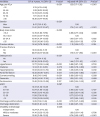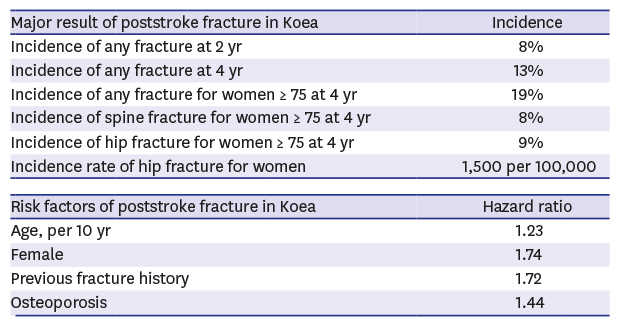1. Feigin VL, Norrving B, Mensah GA. Global burden of stroke. Circ Res. 2017; 120(3):439–448.

2. Statistics Korea. Annual Report on the Cause of Death Statistics 2017. Daejeon: Statistics Korea;2018.
3. Dennis MS, Lo KM, McDowall M, West T. Fractures after stroke: frequency, types, and associations. Stroke. 2002; 33(3):728–734.
4. Pouwels S, Lalmohamed A, Leufkens B, de Boer A, Cooper C, van Staa T, et al. Risk of hip/femur fracture after stroke: a population-based case-control study. Stroke. 2009; 40(10):3281–3285.
5. Brown DL, Morgenstern LB, Majersik JJ, Kleerekoper M, Lisabeth LD. Risk of fractures after stroke. Cerebrovasc Dis. 2008; 25(1-2):95–99.

6. Forster A, Young J. Incidence and consequences of falls due to stroke: a systematic inquiry. BMJ. 1995; 311(6997):83–86.
7. Keene GS, Parker MJ, Pryor GA. Mortality and morbidity after hip fractures. BMJ. 1993; 307(6914):1248–1250.

8. Ha YC, Park YG, Nam KW, Kim SR. Trend in hip fracture incidence and mortality in Korea: a prospective cohort study from 2002 to 2011. J Korean Med Sci. 2015; 30(4):483–488.

9. Kramer AM, Steiner JF, Schlenker RE, Eilertsen TB, Hrincevich CA, Tropea DA, et al. Outcomes and costs after hip fracture and stroke. A comparison of rehabilitation settings. JAMA. 1997; 277(5):396–404.

10. Duan Y, Seeman E. Bone fragility in Asian and Caucasian men. Ann Acad Med Singapore. 2002; 31(1):54–66.
11. Cooper C, Campion G, Melton LJ 3rd. Hip fractures in the elderly: a world-wide projection. Osteoporos Int. 1992; 2(6):285–289.

12. Schwartz AV, Kelsey JL, Maggi S, Tuttleman M, Ho SC, Jónsson PV, et al. International variation in the incidence of hip fractures: cross-national project on osteoporosis for the World Health Organization Program for Research on Aging. Osteoporos Int. 1999; 9(3):242–253.

13. Whitson HE, Pieper CF, Sanders L, Horner RD, Duncan PW, Lyles KW. Adding injury to insult: fracture risk after stroke in veterans. J Am Geriatr Soc. 2006; 54(7):1082–1088.

14. Kerse N, Parag V, Feigin VL, McNaughton H, Hackett ML, Bennett DA, et al. Falls after stroke: results from the Auckland Regional Community Stroke (ARCOS) Study, 2002 to 2003. Stroke. 2008; 39(6):1890–1893.
15. Kapral MK, Fang J, Alibhai SM, Cram P, Cheung AM, Casaubon LK, et al. Risk of fractures after stroke: results from the Ontario Stroke Registry. Neurology. 2017; 88(1):57–64.
16. Feigin VL, Forouzanfar MH, Krishnamurthi R, Mensah GA, Connor M, Bennett DA, et al. Global and regional burden of stroke during 1990–2010: findings from the Global Burden of Disease Study 2010. Lancet. 2014; 383(9913):245–254.

17. Kim BJ, Park JM, Kang K, Lee SJ, Ko Y, Kim JG, et al. Case characteristics, hyperacute treatment, and outcome information from the clinical research center for stroke-fifth division registry in South Korea. J Stroke. 2015; 17(1):38–53.

18. Kim BJ, Han MK, Park TH, Park SS, Lee KB, Lee BC, et al. Current status of acute stroke management in Korea: a report on a multicenter, comprehensive acute stroke registry. Int J Stroke. 2014; 9(4):514–518.

19. Seong SC, Kim YY, Park SK, Khang YH, Kim HC, Park JH, et al. Cohort profile: the National Health Insurance Service-National Health Screening Cohort (NHIS-HEALS) in Korea. BMJ Open. 2017; 7(9):e016640.

20. Lee YK, Yoon BH, Koo KH. Epidemiology of osteoporosis and osteoporotic fractures in South Korea. Endocrinol Metab (Seoul). 2013; 28(2):90–93.

21. Lisabeth LD, Morgenstern LB, Wing JJ, Sanchez BN, Zahuranec DB, Skolarus LE, et al. Poststroke fractures in a bi-ethnic community. J Stroke Cerebrovasc Dis. 2012; 21(6):471–477.

22. Fine JP, Gray RJ. A proportional hazards model for the subdistribution of a competing risk. J Am Stat Assoc. 1999; 94(446):496–509.

23. Choi ES, Shon HC, Kim YM, Kim DS, Park KJ, Lim CO, et al. Is the Incidence Rate of Hip Fractures still Increasing in Korea?: An Epidemiologic Study Based on National Health Insurance Database. J Korean Orthop Assoc. 2016; 51(6):447–454.

24. Ha YC, Kim TY, Lee A, Lee YK, Kim HY, Kim JH, et al. Current trends and future projections of hip fracture in South Korea using nationwide claims data. Osteoporos Int. 2016; 27(8):2603–2609.

25. Huang F, Wang Z, Zhang J, Du W, Su C, Jiang H, et al. Dietary calcium intake and food sources among Chinese adults in CNTCS. PLoS One. 2018; 13(10):e0205045.

26. Lee HJ, Cho JI, Lee HS, Kim CI, Cho E. Intakes of dairy products and calcium and obesity in Korean adults: Korean National Health and Nutrition Examination Surveys (KNHANES) 2007–2009. PLoS One. 2014; 9(6):e99085.

27. Sato Y. Abnormal bone and calcium metabolism in patients after stroke. Arch Phys Med Rehabil. 2000; 81(1):117–121.

28. Lau E, Donnan S, Barker DJ, Cooper C. Physical activity and calcium intake in fracture of the proximal femur in Hong Kong. BMJ. 1988; 297(6661):1441–1443.

29. Chan HH, Lau EM, Woo J, Lin F, Sham A, Leung PC. Dietary calcium intake, physical activity and the risk of vertebral fracture in Chinese. Osteoporos Int. 1996; 6(3):228–232.

30. Kwok TC, Su Y, Khoo CC, Leung J, Kwok A, Orwoll E, et al. Predictors of non-vertebral fracture in older Chinese males and females: Mr. OS and Ms. OS (Hong Kong). J Bone Miner Metab. 2017; 35(3):330–337.

31. Ministry of Health and Welfare, Korea Centers for Disease Control and Prevention. Korea Health Statistics 2005: Korea National Health and Nutrition Examination Survey (KNHANES III). Seoul: Korea Centers for Disease Control and Prevention;2006.
32. Ramnemark A, Nyberg L, Borssén B, Olsson T, Gustafson Y. Fractures after stroke. Osteoporos Int. 1998; 8(1):92–95.

33. Kanis J, Oden A, Johnell O. Acute and long-term increase in fracture risk after hospitalization for stroke. Stroke. 2001; 32(3):702–706.

34. Kim JS, Lee KB, Roh H, Ahn MY, Hwang HW. Gender differences in the functional recovery after acute stroke. J Clin Neurol. 2010; 6(4):183–188.

35. Ugur C, Gücüyener D, Uzuner N, Ozkan S, Ozdemir G. Characteristics of falling in patients with stroke. J Neurol Neurosurg Psychiatry. 2000; 69(5):649–651.

36. Nevitt MC, Cummings SR. The Study of Osteoporotic Fractures Research Group. Type of fall and risk of hip and wrist fractures: the study of osteoporotic fractures. J Am Geriatr Soc. 1993; 41(11):1226–1234.

37. Grisso JA, Kelsey JL, Strom BL, Chiu GY, Maislin G, O'Brien LA, et al. Risk factors for falls as a cause of hip fracture in women. N Engl J Med. 1991; 324(19):1326–1331.

38. Fried LF, Shlipak MG, Stehman-Breen C, Mittalhenkle A, Seliger S, Sarnak M, et al. Kidney function predicts the rate of bone loss in older individuals: the Cardiovascular Health Study. J Gerontol A Biol Sci Med Sci. 2006; 61(7):743–748.

39. Yi DW, Khang AR, Lee HW, Son SM, Kang YH. Association between serum cystatin C and bone mineral density in Korean adults. Ther Clin Risk Manag. 2017; 13:1521–1528.

40. Yamada S, Taniguchi M, Tokumoto M, Yoshitomi R, Yoshida H, Tatsumoto N, et al. Modified creatinine index and the risk of bone fracture in patients undergoing hemodialysis: the Q-Cohort study. Am J Kidney Dis. 2017; 70(2):270–280.

41. Vestergaard P, Olsen ML, Paaske Johnsen S, Rejnmark L, Sørensen HT, Mosekilde L. Corticosteroid use and risk of hip fracture: a population-based case-control study in Denmark. J Intern Med. 2003; 254(5):486–493.

42. Lee TA, Weiss KB. Fracture risk associated with inhaled corticosteroid use in chronic obstructive pulmonary disease. Am J Respir Crit Care Med. 2004; 169(7):855–859.

43. Viniol A, Hickstein L, Walker J, Donner-Banzhoff N, Baum E, Becker A. Influence of thyroid hormone therapy on the fracture rate - A claims data cohort study. Bone. 2016; 86:86–90.

44. Vestergaard P, Rejnmark L, Mosekilde L. Fracture risk associated with parkinsonism and anti-Parkinson drugs. Calcif Tissue Int. 2007; 81(3):153–161.

45. Wagner AK, Ross-Degnan D, Gurwitz JH, Zhang F, Gilden DB, Cosler L, et al. Effect of New York State regulatory action on benzodiazepine prescribing and hip fracture rates. Ann Intern Med. 2007; 146(2):96–103.

46. Hwang JS, Oh SH, Oh KS, Lee KU, Woo JM, Lee BC, et al. Association of fracture risk with benzodiazepine among adults in South Korea. Int J Clin Pharmacol Ther. 2015; 53(2):163–171.

47. Vestergaard P, Rejnmark L, Mosekilde L. Proton pump inhibitors, histamine H2 receptor antagonists, and other antacid medications and the risk of fracture. Calcif Tissue Int. 2006; 79(2):76–83.

48. Van Leeuwen BL, Verkerke GJ, Hartel RM, Sluiter WJ, Kamps WA, Jansen HW, et al. Chemotherapy decreases epiphyseal strength and increases bone fracture risk. Clin Orthop Relat Res. 2003; 413:243–254.









 PDF
PDF Citation
Citation Print
Print




 XML Download
XML Download